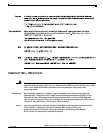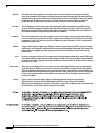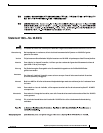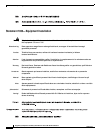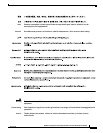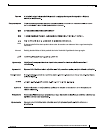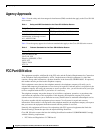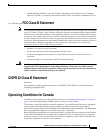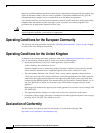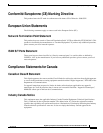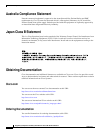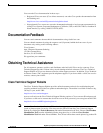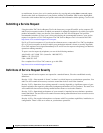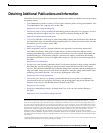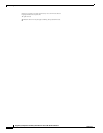
21
Regulatory Compliance and Safety Information for Cisco SB 100 Series Routers
78-16777-01
Cisco SB 100 seriesFCC Class B Statement
• TIA/EIA/IS-968, Technical Criteria for Terminal Equipment to Prevent Harm to the Telephone
Network, July 2001, as adopted by the Administrative Council on Terminal Attachments (ACTA).
Cisco SB 100 series
FCC Class B Statement
Note This equipment has been tested and found to comply with the limits for a Class B digital device, pursuant
to part 15 of the FCC Rules. These limits are designed to provide reasonable protection against harmful
interference in a residential installation. This equipment generates, uses and can radiate radio frequency
energy and, if not installed and used in accordance with the instructions, may cause harmful interference
to radio communications. However, there is no guarantee that interference will not occur in a particular
installation. If this equipment does cause harmful interference to radio or television reception, which can
be determined by turning the equipment off and on, the user is encouraged to try to correct the
interference by one or more of the following measures:
• Reorient or relocate the receiving antenna
• Increase the separation between the equipment and the receiver
• Connect the equipment into an outlet on a circuit different from that to which the receiver is
connected.
• Consult the dealer or an experienced radio/TV technician for help.
Warning
Modification of this equipment without Cisco's authorization may result in this equipment no longer
complying with FCC requirements for Class B digital devices. In that event, your right to use the
equipment may be limited by FCC regulations, and you may be required to correct any interference to
radio or television communications at your own expense.
CISPR 22 Class B Statement
Emissions:
This equipment complies with the requirements of CISPR 22 (EN 55022) for Class B Information
Technology Equipment (ITE).
Operating Conditions for Canada
In addition to the warnings and safety guidelines listed in the “Obtaining Documentation” section on
page 24, the following operating condition applies to routers used in Canada:
The Industry Canada label identifies certified equipment. This certification means that the equipment
meets certain telecommunications network protective, operational, and safety requirements as
prescribed in the appropriate Terminal Equipment Technical Requirements documents. The Department
does not guarantee the equipment will operate to the user’s satisfaction.
Before installing the equipment, users should ensure that it is permissible to be connected to the facilities
of the local telecommunications company. The equipment must also be installed using an acceptable
method of connection. The customer should be aware that compliance with the above conditions may
not prevent degradation of service in some situations.



